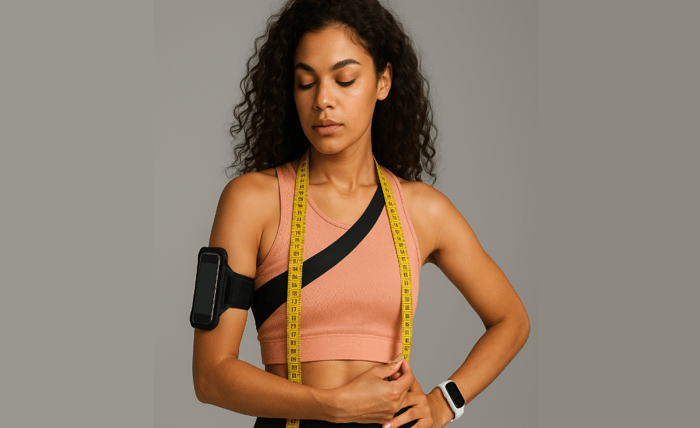Every decade, silhouettes shift. Not just on runways, but in minds and muscles. The shapes we chase aren’t arbitrary; they emerge from social metabolism, fed by trends, trauma, and technology. Fashion is no longer decoration. It functions as a public index of health—perceived, real, or idealized.
Today, the body isn’t merely clothed—it is calculated. Waistlines aren’t hemmed with fabric, they’re framed by metrics. Wellness apps sync with outfit algorithms. What you wear might track your steps, monitor sweat, or alert you to rising cortisol. Sartorial design has entered the bloodstream, both metaphorically and, with wearables, quite literally.
Some seek refuge in nostalgic cuts, returning to styles from eras when food felt less processed and rest less scarce. Others lean into futurism, choosing synthetic materials that promise resilience—clothes that don’t wrinkle, stain, or even smell. These aren’t style choices; they are adaptive signals, responses to stress environments both personal and planetary.
And amid all this recalibration, even activities once considered unrelated to aesthetics are blending in. One can now track biometric changes during competitive gaming, with platforms like 22Bet login quietly blurring the line between sport, screen, and self-monitoring. The message is clear: performance is everywhere, and how you present your body often reflects how well it’s performing inside.
The Era Of Bio-Fashion
In former decades, fashion followed fantasy. Designers projected surrealism, defiance, or elegance. Now, they forecast biology. Anti-odor fabrics. UV-reactive fibers. Outfits built to regulate temperature, stimulate circulation, or reduce friction. These aren’t just garments—they’re engineered ecosystems.
Runways in Tokyo and Berlin now display fabrics that respond to pulse rate or skin pH. “Smart textiles” read the wearer and adjust accordingly. This isn’t couture—it’s coded clothing. One day, a jacket might know you’re anxious before your therapist does.
But as the body becomes more readable, it also becomes more vulnerable. Who owns the data your shoes collect when they correct your posture? What happens when insurers request the metrics your shirts recorded last summer? Fashion used to hide imperfections. Now it might report them.
Self-Care Or Surveillance?
The word “wellness” echoes everywhere now, but its implications vary. Some see in it a return to self-respect. Others hear subtle pressure. Is your outfit breathable enough? Is your skin glowing beneath it? Have you achieved the “natural” look—one which takes hours, products, and a curated diet?
Fashion campaigns once sold image. Now they sell routines. A model’s glow isn’t just lighting; it’s hydration, detox, intermittent fasting, gut flora. Garments are designed not just to enhance shape but to showcase discipline.
And the consumer internalizes this. A shirt that tracks posture might improve spine alignment—or introduce anxiety every time you slouch. A breathable yoga set may boost flexibility—or become a reminder that you skipped your session. In short: fashion becomes feedback.
Chronic Trends And Timeless Injuries
Ironically, the more health-aware fashion becomes, the more injuries it still inflicts. “Clean sneakers” trends ruin arches. Heavy earrings resurface as symbols of status, reawakening nerve pain. Ultra-tight tailoring, once abandoned, returns as “snatched” silhouettes. The tension is chronic.
Meanwhile, fast fashion accelerates depletion. Workers suffer, soils deplete, and the air chokes. Yet somehow, the final product is marketed as wellness. It’s a paradox: a dress labeled “eco-cotton” might have traveled ten thousand kilometers before reaching your skin. Sustainable tags dangle off unsustainable supply chains.
What’s worn close to the body often comes at a cost to other bodies, far from view.
Health Is Now Visual
Instagram didn’t invent health aesthetics, but it accelerated them. Smooth skin, toned abs, soft lighting. It’s not just what you do—it’s how it looks in a cropped square. Clothing becomes props in a health narrative. A cropped hoodie after a morning run. Linen pajamas and green tea before bed. What matters isn’t just what you wear, but when, where, and how visibly.
This performative health culture reshapes shopping habits. Athleisure, once a niche, now defines entire wardrobes. People wear leggings not because they’ll stretch—but because they look like someone who might. Performance becomes posture, and vice versa.
Even the face participates. Masks once meant for pollution or illness now bear designer logos. An accessory born in crisis becomes couture. In this blend of fear and finesse, we see the logic of modern fashion: functional, but also symbolic.
Care Markets And Their Contradictions
As the fashion-health hybrid market expands, it spawns its own contradictions. A sweatshirt infused with CBD might relax your shoulders. Or it might cost more than a therapist session. Wellness is sold as simplicity—but priced as luxury.
There are winners, of course. Influencers shape entire product lines. Microcelebrities dictate seasonal palettes and nutrition-based wardrobes. Tech companies branch into fitness gear. But for many, this fusion of fashion and health introduces more pressure than relief.
Feeling well becomes indistinguishable from looking well. And if you don’t appear vibrant, toned, and luminous—are you still healthy?
Final Threads: Style As A Pulse
The clothes we choose reflect more than taste. They reflect belief systems—about the body, about value, about safety. Today’s clothing doesn’t just drape; it transmits. It tells stories about your habits, hopes, and how much you’re willing to invest in your own wellbeing.
Fashion isn’t just about looking good. It’s about proving that you’re managing. That you’re adapting. That you’re tuned in.
The fusion of style and health isn’t temporary. It signals a deeper shift, where expression is biological, and even the simplest T-shirt is encoded with meaning. As fashion becomes another limb of the wellness industry, the challenge will be remembering this: true health might not always be photogenic. And true style? It might start when we stop performing altogether.

